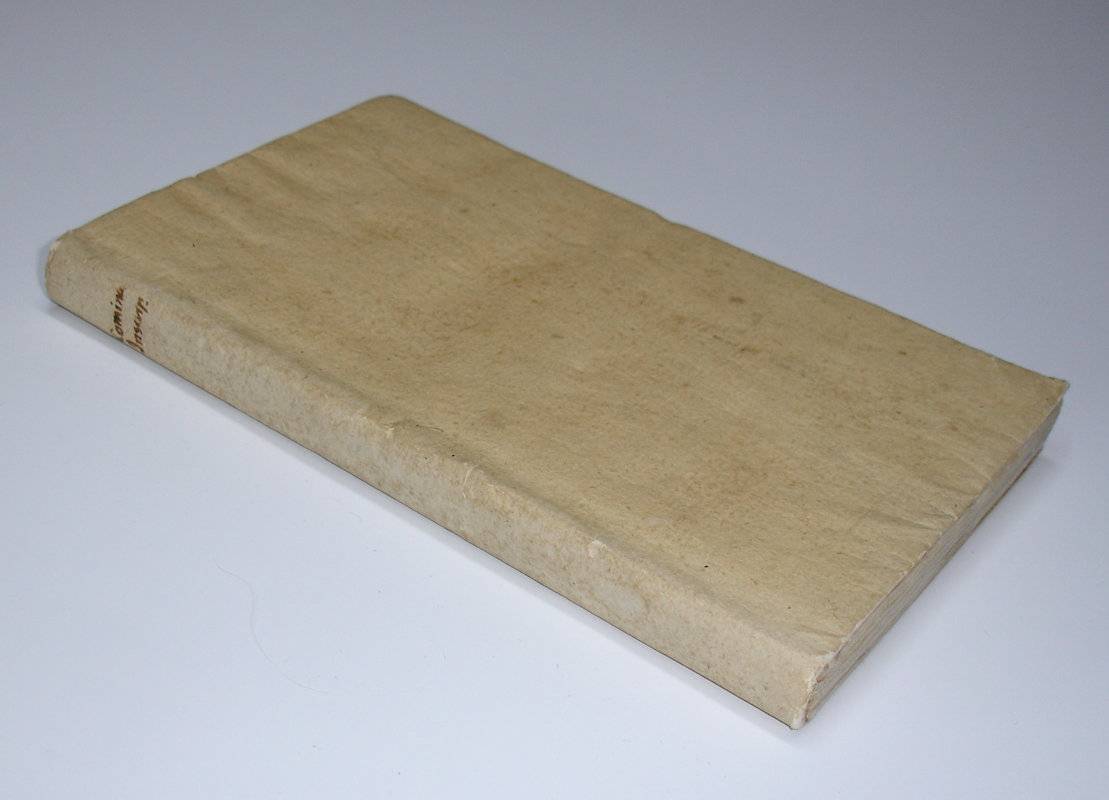ROMANARUM INSCRIPTIONUM FASCICULUS.
Cum explicatione notarum in usum juventutis. (Tironibus rei lapidariae studiosis ut posthabita barbarie quam in plerisque recentibus inscriptionibus eruditi fastidiunt, et nova epigrammata eleganter condere, et vetera interpretari recte discant. Angelus Josephi F. Cominus hunc inscriptionum fasciculum D.D.)
Padua (Patavii), Excudebat Josephus Cominus, Superiorum permissu, 1774.
8vo. (XVI),222 p. Contemporary limp cardboard. 18.5 cm (
Details: Cover still remarkably fresh; woodcut printer's device on title: a man digging for antique objects, Motto: 'Quidquid sub terra est in apricum profert aetas'; the inscriptions in the text are set in all kinds of capitals to make them look like real inscriptions; fresh paper) (
Condition: small slip of paper pasted over a name on the title) (
Note: Why the ICCU attributes this publication to Giovanni Domenico (or Giandomenico) Polcastro (1710-1787) is not quite clear. Perhaps they rely on the
Handbuch der klassischen Literatur by J.J. Eschenburg, Berlin, 1818, p. 74, where the book is attributed to
Comite Polcastro. Or it is attributed to the Padovian Polcastro because the firm of Giuseppe Comino used to print scientific texts produced by professors of the University of Padova, among which in 1773 Polcastro's
Notizia della scoperta fatta in Padova d'un ponte antico con una romana iscrizione. Polcastro was a well known philologist born in Padua. G. Mussato began a
laudatio on him like this:
En Polcaster adest, Patavi lux alma, decusque/ qui domus et patriae nomen ad astra vehit. (G. Vedova.
Biografia degli scrittori padovani II, p. 111/15). However it seems far more probable that the son of Giuseppe Comino (Josephus Cominus), Angelo, produced this anthology. On page 3 we find a kind of subtitle which we have, to elucidate matters, put between brackets immediately after the title, described above. In this 'subtitle' it is stated that
Angelus F. Josephi Cominus gave this
fasciculum inscriptionum to/for students (
tironibus studiosis) who study epigraphy. He wants them to understand old inscriptions better, and to be able to produce them elegantly themselves. After the death of Giuseppe in 1762, his son Angelo continued the firm more than 30 years still using the name of his father in the imprint. The inscriptions of this collection come from 31 sources, among which Gruter, Montfaucon & Muratori. After each inscription the source is mentioned; the collection is devided into 12 classes: 1:
Diis sacra; 2:
templa, aedes sacrae; 3:
elogia; 4:
opera publica; 5:
senatus consulta, leges et plebescita; 6:
monumenta historica; 7
militaria officia; 8:
tituli sepulcrales; 9:
opera figulina; 10:
monumenta christianorum; 11:
carmina ex lapidibus; 12:
appendix miscellanea; & 22 p.of
notae) (
Collation: *8, a-e8, f-i4, k-p8, q-r4 (minus blank leaf r4) (Photographs on request)
Book number: 120389 Euro 175.00
Keywords: (Oude Druk), (Rare Books), Altertumswissenschaft, Altphilologie, Antike, Antiquity, Classical art and archaeology, Denkmal, Einschriften, Statue, classical philology, inscriptions, klassische Archäologie und Kunst, statues
 ROMANARUM INSCRIPTIONUM FASCICULUS.
ROMANARUM INSCRIPTIONUM FASCICULUS.

